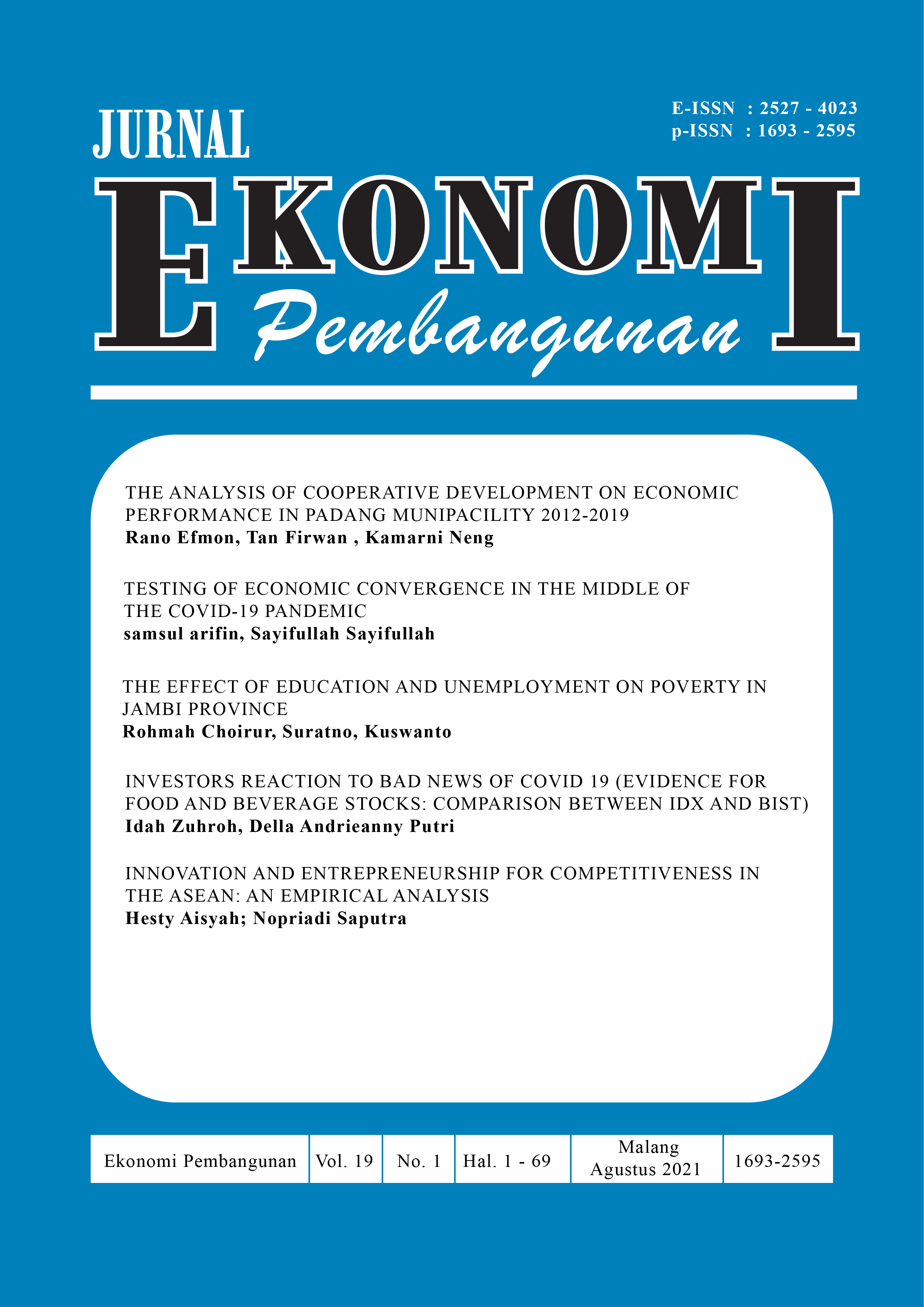Testing Of Economic Convergence In The Middle Of The Covid-19 Pandemic
DOI:
https://doi.org/10.22219/jep.v19i01.15960Keywords:
Convergence, Export-Import, Dynamic Panel, Spatial EconometricAbstract
This study aims to see whether the process of export and import convergence occurs with the control variable of the size of the country's economy affected by the COVID-19 pandemic as measured by GDP and spatial interactions. The method of analysis in this study uses the Spatial Dynamic Panel. The research objects are 64 countries affected by the COVID-19 pandemic—data taken in the period 2019q4-2020q3. The results show that GDP and spatial elements influence the process of export and import convergence. The speed of convergence and the length of time to reach a steady-state, imports are better than exports reaching 28-38% with about one semester and reaching 15-16% with a duration of 1 year (export model). Exports and imports during the COVID-19 pandemic reflect interactions between countries, with distance as a determining factor. However, the role of interaction between countries tends to be insignificant in the long run.
Downloads
References
Barro, R. J., & Sala-I-Martin, X. (1992). Convergence. Journal of Political Economy, 223–251. https://doi.org/10.1086/261816
Barua, S. (2020). COVID-19 pandemic and world trade : Some analytical notes, (April), 1–35.
Chakravarty, S. L., & Chakrabarty, R. (2014). A Gravity Model Approach to Indo-ASEAN Trade-fluctuations and Swings. Procedia - Social and Behavioral Sciences, 133, 383–391. https://doi.org/10.1016/j.sbspro.2014.04.205
Elhorst, J. P. (2003). Specification And Estimation Of Spatial Panel Data Models. International Regional Science Review, 26(3), 244–268. https://doi.org/10.1007/978-3-642-40340-8
Irawan, T. (2018). Spatial econometrics dengan stata. IPB International Certified Training.
Islam, N. (2003). What have we learnt from the convergence debate? Journal of Economic Surveys, 17(3), 309–362. https://doi.org/10.1111/1467-6419.00197
Lall, S. V., & Yilmaz, S. (2001). Regional economic convergence: Do policy instruments make a difference? The Annals of Regional Science, 35(1), 153–166. https://doi.org/10.1007/s001680000035
McKibbin, W. J., & Fernando, R. (2020). The Global Macroeconomic Impacts of COVID-19: Seven Scenarios. SSRN Electronic Journal. https://doi.org/10.2139/ssrn.3547729
Önder, A., Karadag, M., & Deliktas, E. (2007). The effects of public capital on regional convergence in Turkey. Turkey. Retrieved from http://www.iibf.ege.edu.tr/economics/papers/wp07-01.pdf
Paas, T., Kuusk, A., Schlitte, F., & Võrk, A. (2007). Econometric Analysis of Income Convergence in Selected EU Countries and Their Nuts 3 Level Regions. SSRN Electronic Journal. https://doi.org/10.2139/ssrn.1078863
Roberts, B. A. (2004). A gravity study of the proposed China-ASEAN free trade area. International Trade Journal, 18(4), 335–353. https://doi.org/10.1080/08853900490518208
Ruiz Estrada, M. A. (2020). Economic Waves: The Effect of the Wuhan COVID-19 on the World Economy (2019-2020). SSRN Electronic Journal. https://doi.org/10.2139/ssrn.3545758
Schmtt, C., & Starke, P. (2011). Explaining convergence of OECD welfare states: a conditional approach. Journal of European Social Policy, 21(2), 120–135. https://doi.org/10.1177/0958928709XXXXXX
Vayá-Valcarce, E., & Villar Frexedas, O. (2005). Financial contagion between economies: an Exploratory Spatial Analysis. Estudios de Economía Aplicada, 23(1), 151–166.
Ward, M., & Gleditsch, K. (2007). An introduction to spasial regression models in the social science. Antimicrobial Agents and Chemotherapy, 58(12), 7250–7257. https://doi.org/10.1128/AAC.03728-14
Yu, Ji., & Lee, L.-F. (2012). Convergence: A Spatial Dynamic Panel Data Approach. Global Journal of Economics, 01(01), 1–39. https://doi.org/10.1142/S2251361212500061
Downloads
Published
Issue
Section
License
Copyright (c) 2021 Jurnal Ekonomi Pembangunan

This work is licensed under a Creative Commons Attribution-ShareAlike 4.0 International License.
Authors who publish with Jurnal Ekonomi Pembangunan (JEP) agree to the following terms:
- For all articles published in Jurnal Ekonomi Pembangunan (JEP), copyright is retained by the authors. Authors permit the publisher to announce the work with conditions. When the manuscript is accepted for publication, the authors agree to the publishing right's automatic transfer to the publisher.
- Authors retain copyright and grant the journal right of first publication with the work simultaneously licensed under a Creative Commons Attribution-NonCommercial-ShareAlike 4.0 International License that allows others to share the work with an acknowledgment of the work's authorship and initial publication in this journal.
- Authors can enter into separate, additional contractual arrangements for the non-exclusive distribution of the journal's published version of the work (e.g., post it to an institutional repository or publish it in a book), with an acknowledgment of its initial publication in this journal.
- Authors are permitted and encouraged to post their work online (e.g., in institutional repositories or on their website) before and during the submission process, as it can lead to productive exchanges and earlier and greater citation of published work (See The Effect of Open Access).

This work is licensed under a Creative Commons Attribution-NonCommercial-ShareAlike 4.0 International License.






















